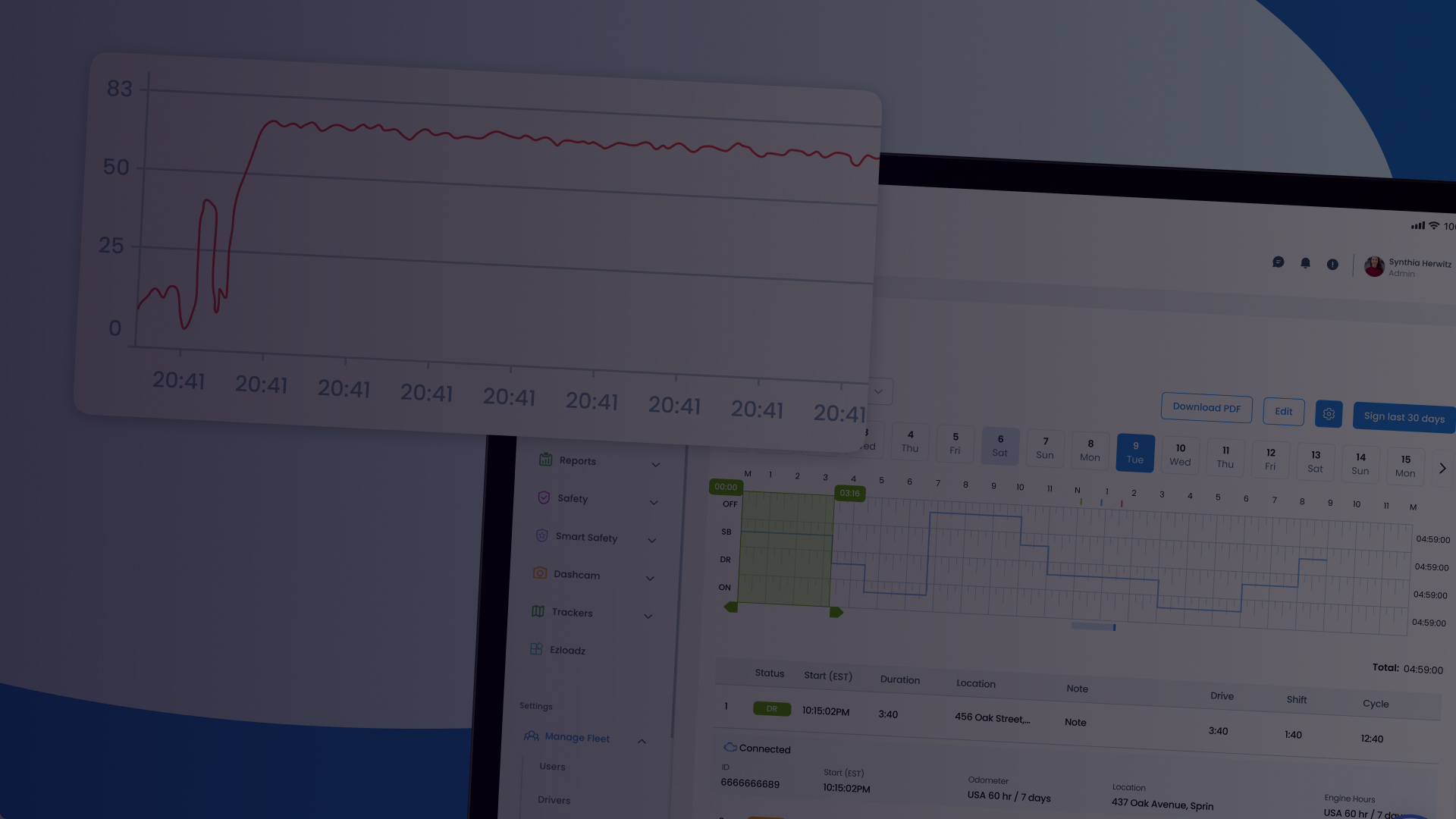Fuel has never been a small line‑item, but in 2025 it often determines whether a trucking operation grows or merely survives. Diesel prices remain volatile, sustainability targets are tightening, and shippers are tracking carriers’ carbon footprints.
In this environment, “good MPG” is no longer a nice‑to‑have. It is a strategic lever that touches every metric you care about: cost per mile, on‑time‑delivery, maintenance cycles, and even driver retention (nobody enjoys stopping at the pump twice as often as the guy in the next lane).
This guide covers vehicle choice, real‑world operating variables, and the data layer that turns fuel numbers into an actionable KPI. Read on to get a detailed roadmap for cutting burn rates without sacrificing payload or uptime, based on the expertise provided by Ezlogs.
Why Fuel Efficiency Is Bigger Than Fuel‑Cost Savings
Fuel efficiency is basically the most important factor when choosing a track due to:
- Operating margin pressure. A one‑point improvement in fleet‑wide MPG can add thousands of dollars of margin per truck, per year when diesel hovers near $4 per gallon.
- Sustainability mandates. Shippers’ RFPs increasingly ask for hard emission data. High‑MPG trucks lower both Scope 1 (your own fuel use) and customers’ Scope 3 emissions.
- Downtime prevention. Trucks spec’d for efficiency typically include engines, aero kits, and predictive maintenance sensors engineered to run cooler and wear more slowly.
- Driver satisfaction. Hybrids and next‑gen diesels operate at lower RPMs, generating less vibration and noise. These are quality‑of‑life perks that help you keep hard‑to‑replace CDL talent.
Best Fuel-Efficient Pickup Trucks in 2025
The following trucks are leading the way in fuel economy this year. Each offers impressive mileage while maintaining strength and load capacity.
Top Trucks Ranked by MPG (Miles Per Gallon)
Hybrid powertrains are moving from novelty to mainstream, led by Ford and Toyota. Below are the stand‑outs that blend class‑leading mileage with impressive towing figures.
| Model & Powertrain | EPA / OEM MPG | Why It Matters |
| Ford Maverick Hybrid (2.5 L I‑4 HEV, FWD/AWD) | 42 MPG city / 37 MPG combined | Compact footprint for urban parcel work; new AWD hybrid option keeps economy high without limiting cold‑weather traction. |
| Toyota Tacoma Hybrid (2.4 L i‑FORCE MAX) | 40 MPG‑plus (est.) | Toyota finally brings hybrid tech to the midsize truck segment; early fleet pilots point to diesel‑like torque with gasoline pricing. |
| Ram 1500 HFE / EcoDiesel (3.0 L V6) | 26 MPG combined | HFE aero package plus stop‑start cuts fuel use on regional lanes without sacrificing a full‑size bed. |
| Chevrolet Silverado 1500 Duramax Diesel (3.0 L I‑6) | 27 MPG highway | Updated thermal management lets the Duramax deliver SUV‑like efficiency in a 13,300‑lb‑tow‑rated truck. |
Fuel-Efficient Diesel Trucks for Hauling
While pickups capture headlines, Class 8 tractors burn the lion’s share of fleet fuel. Three 2024‑25 platforms prove that double‑digit MPG is achievable today.
| Model & Powertrain | EPA / OEM MPG | Why It Matters |
| Freightliner Cascadia (Detroit DD15 Gen 5) | ~10 mpg in driver‑monitored field tests | Asymmetric turbo, down‑sped driveline, predictive cruise, and aero skirts cut parasitic losses. |
| Volvo VNL D13 Turbo Compound + I‑Torque | 8.5 mpg at 85 mph (OEM data) | Turbo‑compound recovers waste heat and an overdrive I‑Shift lets the engine loaf below 1 200 rpm on gentle grades. |
| Kenworth T680 Next Gen (PACCAR MX‑13) | 10.14 mpg on a 14 000‑mile real‑world run | Nose‑to‑tail aero redesign, digital mirror package, and low‑rolling‑resistance tires deliver sleeper‑cab efficiency once reserved for day‑cabs. |
Picking the right iron can produce a 25‑30 % swing in annual fuel spend before you touch telematics or coaching.
What Affects Fuel Efficiency on the Road?
Even the best‑spec’d truck leaks fuel economy when operational discipline falters. Key culprits and their approximate impact on mileage.
Key Factors That Impact MPG
- Aggressive acceleration / braking: ‑20 % MPG on mixed routes;
- Excessive idling (>25 % engine time): ‑0.5 mpg on highway tractors;
- Improper tire pressure: ‑1 % MPG per 5 psi below spec;
- Roof racks, open windows, or missing aero panels: ‑4–6 % at 65 mph;
- Overloading beyond ideal torque band: Varies, but turbo diesels can lose 15 % efficiency when forced to climb above 1 500 rpm for long stretches.
Tools That Help: ELD + Fleet Management
Using an ELD system like Ezlogz helps you track driving behavior, idling time, and route efficiency — all of which affect fuel consumption. You can set alerts, monitor logs, and identify trends that point to inefficiencies. Learn more about our offer here.
How Ezlogz Helps You Improve Truck Fuel Efficiency
Hardware and horsepower set the theoretical ceiling; telematics determines how close you fly to that ceiling every day. Ezlogz mixes an FMCSA‑compliant ELD with an analytics stack purpose‑built for fuel management:
- Real‑time fuel‑burn dashboard — isolates MPG by driver, truck, lane, and even weather band;
- Idle‑time heat maps — color‑code detention hotspots so you can renegotiate contracts or deploy auxiliary power units (APUs);
- Predictive route optimizer — blends GPS, live traffic, and elevation data to propose the least‑fuel‑intensive path rather than the simply shortest one;
- Driver gamification module — ranks operators on smooth throttle, brake scores, and cruise‑control utilization. Top performers earn badges or cash bonuses; under‑performers get automated coaching clips;
- Maintenance‐triggered alerts — ties fuel anomalies to fault codes (e.g., clogged DPF, bad NOx sensor) before MPG losses become breakdowns.
When fleets make fuel consumption visible down to the VIN, they typically recover 3–7 % MPG in the first quarter of deployment—often worth more than the entire annual telematics bill.
Which Truck Gets the Best Gas Mileage for You?
If you’re a dispatcher, fleet owner, or independent driver, the answer depends on your load type, route, and goals. Use this guide as a reference — and pair it with Ezlogz for the full picture.
- Urban delivery / last‑mile couriers → compact hybrids (Maverick, Santa Cruz) keep fuel and parking headaches minimal.
- Mixed regional routes with 5‑10 k lbs payloads → midsize hybrids (Tacoma) or light‑duty diesels (Canyon 2.7 Turbo) balance economy and bed volume.
- Heavy long‑haul (>70 k GVW) → aero‑optimized Class 8 diesels (Cascadia, T680, VNL) paired with 2.15–2.47 rear‑axle ratios.
- Data‑first enterprises → any platform, provided it feeds granular CAN bus data to Ezlogz for real‑time optimization.
Quick ROI Calculation
Let’s imagine that these are your numbers:
- Fleet size: 50 tractors;
- Average annual miles: 95 000 per truck;
- Baseline MPG: 6.8;
- Diesel price: $4.10 / gallon.
| Change | New MPG | Annual Fuel Gallons | Annual Savings |
| Adopt T680 Next Gen spec + driver training | 7.5 | 633 333 | $1.23 M |
| Layer Ezlogz analytics & idle policy | 7.9 | 600 633 | +$213 k extra |
A combined 1.1MPG gain yields $1.44 million in yearly savings. That’s enough to self‑fund further truck upgrades or pay retention bonuses that keep seasoned drivers behind the wheel.
Ready to Track and Improve Your Fleet’s MPG?
Fuel will stay your biggest variable cost. The fleets that win in 2025 will be the ones that treat every gallon as a data point—and use that data to fine‑tune trucks, routes, and driving habits in real time.
Ezlogz gives you the cockpit view to do exactly that:
- Live MPG dashboards down to the VIN;
- Automated idle‑and‑speed violation alerts;
- Trip‑based route optimization;
- Driver coaching and incentive tracking;
- Seamless FMCSA compliance.
Try Ezlogz today and make fuel efficiency part of your logistics strategy.











Comments